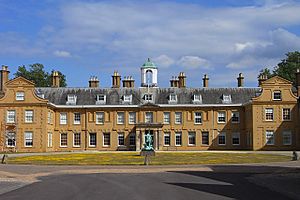George Pitt (died 1735) facts for kids
George Pitt (born around 1663, died 1735) was an important landowner from Strathfield Saye in Hampshire, England. He was also a politician who belonged to the Tory party. He served as a member of the House of Commons, which is like a part of the British Parliament, for many years between 1694 and 1727.
Early Life and Family
George Pitt was the oldest son of George Pitt, who also lived at Strathfield Saye, and his mother, Jane Savage. He started studying at Wadham College, Oxford when he was 16 years old, in 1680.
In 1691, George Pitt married Lucy Lowe. She was a widow and her family owned land in Wiltshire and Dorset. This marriage helped George Pitt's son gain more land in Dorset later on. In 1694, George Pitt's father passed away, and George inherited a lot of wealth. This included Strathfieldsaye, other estates, and valuable coal mines in Durham. These properties gave him a strong influence in elections in certain areas.
After Lucy Pitt passed away in 1697, George married Lora Grey by 1700. Lora also brought more property in Dorset to the family. For many years, George Pitt worked closely with his relative, Governor Thomas Pitt. Governor Pitt even trusted George with looking after his children and the famous Pitt diamond.
Political Journey
George Pitt became a Member of Parliament (MP) for Stockbridge in 1694. An MP is a person elected to represent a group of people in the House of Commons. He later became an MP for Wareham in 1698. He was known as a supporter of the Country party, which often opposed the government.
In 1702, George Pitt became a Freeman of Portsmouth. This was an honor that gave him certain rights in the town. He was also elected as a Tory MP for Hampshire that same year, while still holding his seat for Wareham. From this time, the name 'Mr Pitt' appeared often in Parliament records. However, there were several Pitt family members in Parliament, so it's sometimes hard to know which 'Mr Pitt' was being referred to.
In 1705, he was re-elected for Wareham. He voted against the government's choice for Speaker of the House, supporting the Tory candidate, William Bromley. George Pitt was elected again for Wareham in 1708. He voted against the impeachment (a formal accusation of wrongdoing) of Dr. Henry Sacheverell in 1710.
By 1710, George Pitt was confident enough to stand for Hampshire again and was elected as the top Tory MP. He also kept his seat at Wareham as a backup. He suggested that all the money from the land tax should go to support the navy, but this idea was not accepted. George Pitt was seen as one of the "worthy patriots" who pointed out problems with the previous government. He was also involved in setting up the South Sea Company, which was a large trading company. He became a director of this company from 1711 to 1718. In 1713, he opposed a bill about trade with France.
In 1715, George Pitt was elected for both Wareham and Hampshire. He chose to represent Hampshire, and his son George took the seat for Wareham. As a Tory, he usually voted against the government's plans. By 1716, he was a Commissioner for building 50 new churches. In 1722, he was elected for Old Sarum at a special election in 1726. He did not run for election again in 1727.
Later Life and Legacy
George Pitt passed away on February 28, 1735, and was buried at St Mary's church in Stratfield Saye. He had four sons and five daughters from his second marriage. His son, also named George, inherited the family estate of Strathfield Saye.


